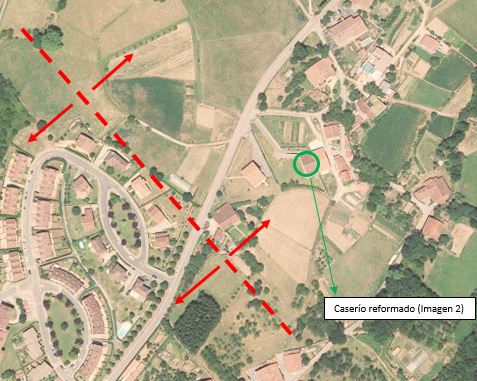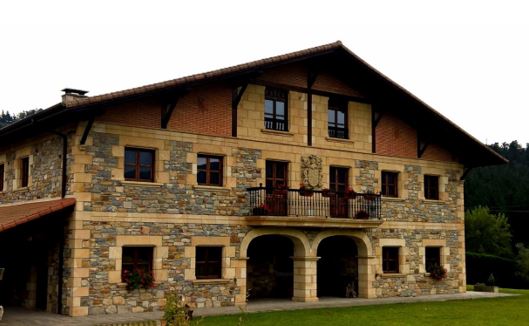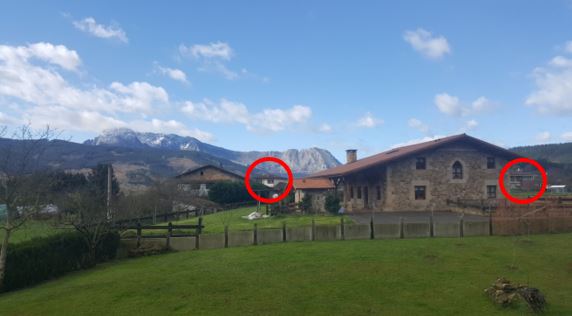Julen Iruarrizaga Master in Road, Canal and Port Engineering.
In this reflection around the Basque farmhouse, the history that precedes it will be briefly analyzed in the socio-economic context and also its importance in the present, being today Cultural Heritage of the Basque Country, obtaining an important role when it comes to preserving this heritage through regulations of the Land Management.
The Basque farmhouse, in Basque “Basoko herria- Baserria” which implicitly means Forest Community, went from being a simple wooden hut and covered with a plant roof; becoming, in what is now known as the modern Basque farmhouse, a wooden structure composed of stone facades.
Historically, the hamlet not only referred to the house itself, but also to the communal lands that made up it. These lands were essential for the economic livelihood of the hamlet; from agriculture to imports abroad, for example, of weapons manufactured by blacksmiths in the hamlets themselves (spearheads for spades).
Currently, there is no hamlet more than 500 years old, however, there are remains of those communities. Samples of this were found in the Besoitaormaetxea hamlet in Berriz (Biscay) after finding foundations of the eleventh century, becoming the oldest dating Basque hamlet.
Social peace, the establishment of the entailed estate and the technology of carpentry and stonework imported from Europe led to the flourishing of the modern Basque farmhouse, the hamlet that can be seen and inhabited today; unique and emblematic buildings that take on a significant importance in the Cultural Heritage of the territory, when it comes to preserving them and making new homes that can be designed technically conditioned by them.
However, industrialization radically changed the rules of the game in the operating structure that the farmhouse as the flourishing of steel mills, textiles, cement mills and bins attracted surpluses of the rural population and caused first, the abandonment of less productive hamlets, eventually also ending with many of the most productive, which led large owners to lose interest in their agricultural heritage amassed over generations. Without a doubt, it was a time when the existence of the hamlet was in danger.
However, in the 80-90s, in full increase in the large cities of the Basque Country, society realized the quality of life provided by the rural area, so many people tried to rebuild or reform those hamlets that years ago were uninhabited, assuming absolute uncontrollability since there were hardly any regulations and regulations that were linked to the architectural conservation of the farmhouse. In my view, it took too long to stop nearly two decades of villa proliferation in rural areas, which was probably for political interests; until a new law was created which states that, in the Basque Autonomous Community, the Territorial Planning Guidelines prohibit in non-land bank the use of isolated one or two-family housing not linked to farming. (DOT, 1997. Art. 10.1)
With regard to the constructions that existed previously and that are abandoned allows its recovery by rehabilitation as long as the structure of the house is preserved, at least in height and floor. In addition, the construction of a justified dwelling from the existence of an earlier remainder, such as a pillar or a wall, is prohibited; or as has also been very common to rely on some note from the ancient scriptures; being these, excuses that have often been used to get building permits.
Not only that, but also regulates the reform of homes that were already built previously, in which only those that previously fulfilled this function are considered residential; that is, it is not possible to convert into housing what used to be a stable, for example.

Figure 1 shows a clear example of the urban pressure of new buildings in a rural area of the municipality of Elorrio (Biscay). The territorial structure of the two zones is clearly visible: The first of them, the left area, in which the single-family and semi-detached houses predominate (built before 2000) and in the second, on the right side of the image, is the Cenita neighborhood, composed of several hamlets all two waters and of considerable size with their respective land adjoining agricultural or livestock purposes.

In the latter area, since 2000, various hamlets have been rebuilt due to the structural deterioration they suffered and image number 2 shows the reform of one of them.

Finally, I would like to add one more image to reflect the consequences of the new developments in the rural landscape. Image 3 shows a photograph taken from the Ortuguren hamlet, where you can see the homes of the urbanization in front, without concordance with the characteristic Basque style that the Cenita neighborhood has as a whole.
